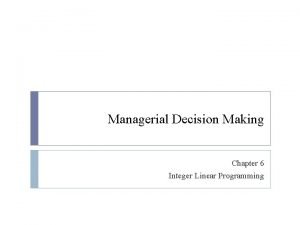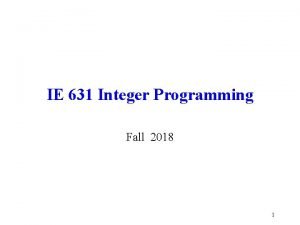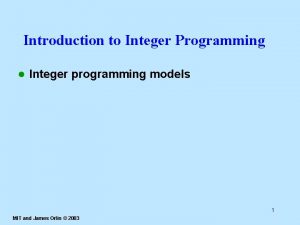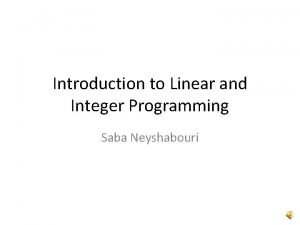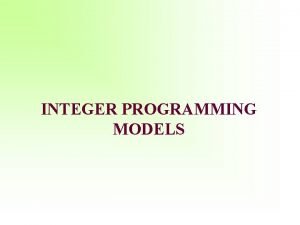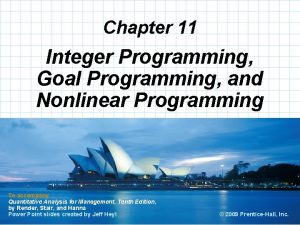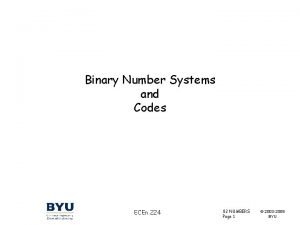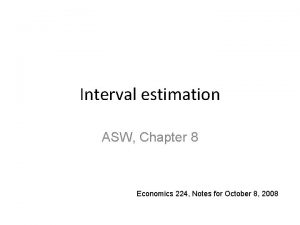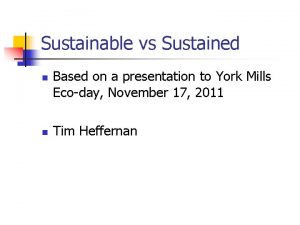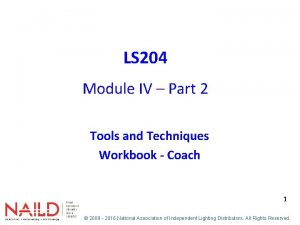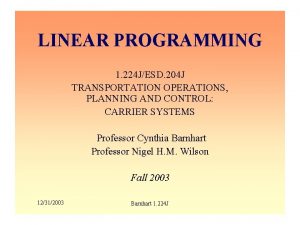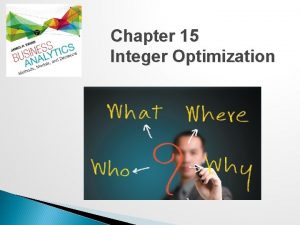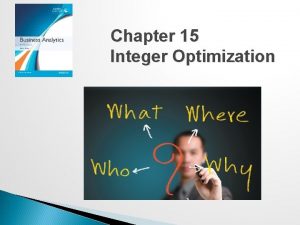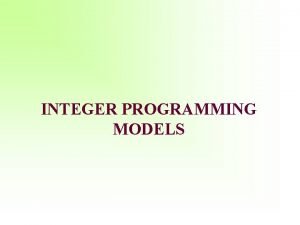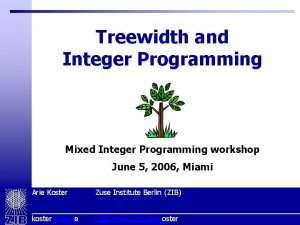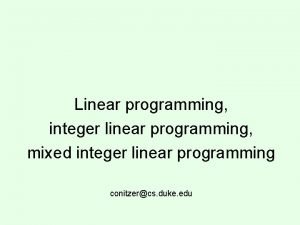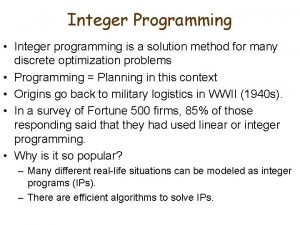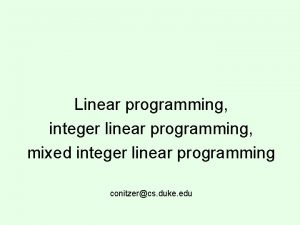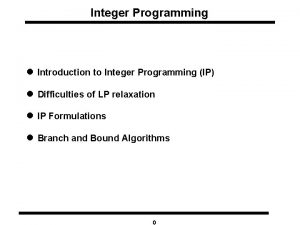INTEGER PROGRAMMING 1 224 JESD 204 J TRANSPORTATION


























- Slides: 26

INTEGER PROGRAMMING 1. 224 J/ESD. 204 J TRANSPORTATION OPERATIONS, PLANNING AND CONTROL: CARRIER SYSTEMS Professor Cynthia Barnhart Professor Nigel H. M. Wilson Fall 2003

IP OVERVIEW Sources: -Introduction to linear optimization (Bertsimas, Tsitsiklis)- Chap 1 - Slides 1. 224 Fall 2000

Outline • When to use Integer Programming (IP) • Binary Choices – Example: Warehouse Location 2 • Restricted range of values • Guidelines for strong formulation • Set Partitioning models • Solving the IP – Linear Programming relaxation – Branch-and bound – Example 12/31/2003 Barnhart 1. 224 J 3

When to use IP Formulation? • IP (Integer Programming) vs. MIP (Mixed Integer • Programming) – Binary integer program • Greater modeling power than LP • Allows to model: – Binary choices – Forcing constraints – Restricted range of values – Piecewise linear cost functions 12/31/2003 Barnhart 1. 224 J 4

Example: Warehouse Location A company is considering opening warehouses in four cities: New York, Los Angeles, Chicago, and Atlanta. Each warehouse can ship 100 units per week. The weekly fixed cost of keeping each warehouse open is $400 for New York, $500 for LA, $300 for Chicago, and $150 for Atlanta. Region 1 requires 80 units per week, region 2 requires 70 units per week, and Region 3 requires 40 units per week. The shipping costs are shown below. Formulate the problem to meet weekly demand at minimum cost. From/To New York Los Angeles Chicago Atlanta 12/31/2003 Region 1 20 48 26 24 Region 2 40 15 35 50 Barnhart 1. 224 J Region 3 50 26 18 35 5

Warehouse Location- Approach • What are the decision variables? – Variables to represent whether or not to open a given • warehouse (yi=0 or 1) – Variables to track flows between warehouses and • regions: xij • What is the objective function? – Minimize (fixed costs+shipping costs) • What are the constraints? – Constraint on flow out of each warehouse – Constraint on demand at each region – Constraint ensuring that flow out of a closed warehouse is 0. 12/31/2003 Barnhart 1. 224 J 6

Warehouse Location- Formulation • Letyi be the binary variable representing whether we open a • warehouse i (yi=1) or not (yi=0). • xij represents the flow from warehouse i to region j • ci= weekly cost of operating warehouse i • tij= unit transportation cost from i to j • W = the set of warehouses; R = the set of regions Forcing constraint 12/31/2003 Barnhart 1. 224 J 7

Warehouse Location- Additional Constraints • If the New York warehouse is opened, the LA warehouse must be opened y. NYC y. LA Relationship constraint 1 1 0 1 or 0 • At most 2 warehouses can be opened Relationship constraint • Either Atlanta or LA warehouse must be opened, but not both Relationship constraint 12/31/2003 Barnhart 1. 224 J 8

Binary Choices • Model choice between 2 alternatives (open or closed, chosen or not, etc) – Set x=0 or x=1 depending on the chosen alternative • Can model fixed or set-up costs for a warehouse • Forcing flow constraints – if warehouse is not open, no flow can come out of it • Can model relationships 12/31/2003 Barnhart 1. 224 J 9

Example: Warehouse Location 2 • A company is looking at adding one or more warehouses somewhere in the R regions which they serve. Each warehouse costs $cw per month to operate and can deliver a total of uw units per month. It costs $cij to transport a unit from the plant in region i to the warehouse in region j. Furthermore, the delivery costs from a warehouse in region j to consumers in region j is zero. Warehouses can service other regions, but the company must pay additional transportation costs of $t per unit per additional region crossed. So to deliver 1 unit from a warehouse in region 2 to a customer in region 4 would cost $(2 · t). Note that the cost to transport a good from warehouse 0 to warehouse R is $(R·t), not $t. All units must travel through a warehouse on their way to the customer. Finally, there is a monthly demand for dj units of the product in region j. Formulate the problem to determine where to locate the new warehouses so as to minimize the total cost each month if the plant is located in region p. 12/31/2003 Barnhart 1. 224 J 10

Example 2: Network Representation d 1 Customer region 1 1, u 1 d 2 2, u 2 Customer region 2 Plant p d 3 3, u 3 Customer region 3 d 4 4, u 4 Customer region 4 d 5 5, u 5 12/31/2003 Customer region 5 Barnhart 1. 224 J 11

Example 2: Approach • Decision Variables? – yi= whether or not we open a warehouse in region i – zij=flow from warehouse i to region j – xpj=flow from plant p to warehouse j. • Objective Function? – MIN (fixed costs+transportation costs from plant to warehouse+transportation costs from warehouse to region) • Constraints? – balance constraints at each warehouse – demand constraints for each region – capacity constraints at each warehouse. • Let aij=cost of delivering a unit from warehouse i to region j, aij=t. |j-i| • Let cpj=cost of transporting one unit from the plant to warehouse j 12/31/2003 Barnhart 1. 224 J 12

Example 2: Formulation 12/31/2003 Barnhart 1. 224 J 13

Example 2: Additional Constraints • At most 3 warehouses can be opened • If you open a warehouse in some region rw 1 or rw 2, you must also open a warehouse in region rw 3 yrw 1 1 0 12/31/2003 Barnhart 1. 224 J yrw 2 0 1 1 0 yrw 3 1 1 1 0 or 1 14

Example 2: Additional Constraints • A plant costs $cp per month to operate and can output up units per month. In this case, a plant can deliver directly to customers in its region at no additional cost, however it cannot deliver directly to customers in other regions; all units traveling out of the plant’s region must pass through a warehouse before their delivery to the customer. Formulate the problem to find the optimal distribution of plants and warehouses. • Additional decision variables: – wi= whether or not we open a plant in region i – ui= amount of flow directly from plant i to region i (no cost) • Objective Function – Additional term to account for the cost of the plants • Revised constraints – Constraints range over all regions, not only region p – Add direct flow from plant to customers in same region – Add constraint that total flow leaving a plant is less than 12/31/2003 Barnhart 1. 224 J 15

Example 2: Network Representation 2 Customer region 1 Plant 2 d 1 1, u 1 d 2 Customer region 2 2, u 2 d 3 Plant 3 3, u 3 Customer region 3 d 4 Plant 5 12/31/2003 4, u 4 Customer region 4 d 5 5, u 5 Customer region 5 Barnhart 1. 224 J 16

Example 2: Formulation 2 12/31/2003 Barnhart 1. 224 J 17

Restricted range of values • Restrict a variable x to take values in a set {a 1, …, a m} • Introduce m binary variables yj, j=1. . m and the constraints 12/31/2003 Barnhart 1. 224 J 18

Guidelines for strong formulation • Good formulation in LP: small number of variables (n) and constraints (m), because computational complexity of problem grows polynomially in n and m • LP: choice of a formulation is important but does not critically affect ability to solve the problem • IP: Choice of formulation is crucial! • Example: aggregation of demand (Warehouse) 12/31/2003 Barnhart 1. 224 J 19

Set Partitioning models • Very easy to write, often very hard to solve • All rules, even non-linear, impractical rules can be respected • Every object is in exactly one set • Huge number of variables (all feasible combinations) 12/31/2003 Barnhart 1. 224 J 20

Linear Programming relaxation • Relax the integrality constraint • Examples: – Xj in Z+ becomes Xj�� 0 – Xj in {0, 1} becomes 0�� Xj �� 1 • If an optimal solution to the relaxation is feasible for the MIP (i. e. , X take on integer values in the optimal solution of the relaxation) => it is also the optimal solution to the MIP • The LP relaxation provides a lower bound on the solution of the IP • Good formulations provide a “tight” bound on the IP 12/31/2003 Barnhart 1. 224 J 21

Branch-and-Bounds: A solution approach for binary Integer programs • Branch-and-bound is a smart enumeration strategy: • – With branching, all possible solutions are enumerated (e. g. 2 number of binary variables) – With bounding, only a (usually) small subset of possible solutions are evaluated before a provably optimal solution is found 12/31/2003 Barnhart 1. 224 J 22

Branch-and-Bound Algorithm Beginning with root node (minimization): • Bound: – Solve the current LP with this and all restrictions along the (back) path to the root node enforced • Prune • – If optimal LP value is greater than or equal to the incumbent solution => Prune – If LP is infeasible => Prune – If LP is integral => Prune • Branch – Set some variable to an integer value • Repeat until all nodes pruned 12/31/2003 Barnhart 1. 224 J 23

Example Company XYZ produces products A, B, C and D. In order to manufacture these products, Company XYZ needs: Profit Nails Screws Glue A 2 10 5 1. 1 B 1. 8 8 6 1. 1 C 1. 82 9 4 0. 9 D 1. 9 10 4 1 Availability 30 15 3. 5 • Company XYZ wants to know which products it should manufacture. • Let XP = 1 if product P is manufactured, 0 otherwise 12/31/2003 Barnhart 1. 224 J 24

Solving the LP 12/31/2003 Barnhart 1. 224 J 25

Branch-and-Bound 1 0. 5714 1 0. 6428 ZLP=-6. 07 X 2=0 1 X 2=1 1 0. 2 1 1 1 ZLP=-5. 92 ZLP=-5. 72 X 1=0 0 1 1 ZLP=-5. 52 X 1=1 1 0 ZLP=-5. 7 RESULT: X 1=1; X 2=0; X 3=1; X 4=1 =>Obj. Value= -5. 72 12/31/2003 Barnhart 1. 224 J 26 1
 Integer rules
Integer rules Jesd interface
Jesd interface Perbedaan linear programming dan integer programming
Perbedaan linear programming dan integer programming Linear vs integer programming
Linear vs integer programming Programing adalah
Programing adalah Gomorys
Gomorys Linear vs integer programming
Linear vs integer programming Mixed integer linear programming
Mixed integer linear programming Fixed charge problem integer programming
Fixed charge problem integer programming Milp model
Milp model Integer programming course
Integer programming course Integer programming mit
Integer programming mit Application of integer programming
Application of integer programming Mixed integer linear programming
Mixed integer linear programming Saba neyshabouri
Saba neyshabouri Integer programming example
Integer programming example Mixed integer linear programming
Mixed integer linear programming Integer programming problem
Integer programming problem Convert 4610 into bcd code
Convert 4610 into bcd code Sex 204
Sex 204 Asw 224
Asw 224 Common code
Common code On average 113 204 aluminum cans are recycled in a minute
On average 113 204 aluminum cans are recycled in a minute Mat 224
Mat 224 Ocho enteros
Ocho enteros 204
204 Iso tc 224
Iso tc 224








